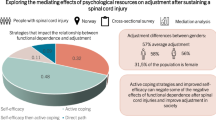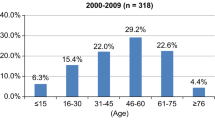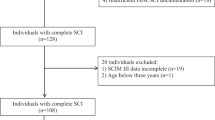Abstract
Study design
Secondary analysis of prospectively collected observational data.
Objectives
To assess the representativeness of the Spinal Cord Injury Model Systems National Database (SCIMS-NDB) of all adults aged 18 years or older receiving inpatient rehabilitation in the United States (US) for new onset traumatic spinal cord injury (TSCI).
Setting
Inpatient rehabilitation centers in the US.
Methods
We compared demographic, functional status, and injury characteristics (nine categorical variables comprising of 46 categories and two continuous variables) between the SCIMS-NDB (N = 5969) and UDS-PRO/eRehabData (N = 99,142) cases discharged from inpatient rehabilitation in 2000–2010.
Results
There are negligible differences (<5%) between SCIMS-NDB patients and the population for 31 of the 48 comparisons. Minor differences (5–10%) exist for age categories, sex, race/ethnicity, marital status, FIM Motor score, and time from injury to rehabilitation admission. Important differences (>10%) exist in mean age and preinjury occupational status; the SCIMS-NDB sample was younger and included a higher percentage of individuals who were employed (62.7 vs. 41.7%) and fewer who were retired (10.2 vs. 36.1%).
Conclusions
Adults in the SCIMS-NDB are largely representative of the population of adults receiving inpatient rehabilitation for new onset TSCI in the US. However, users of the SCIMS-NDB may need to adjust statistically for differences in age and preinjury occupational status to improve generalizability of findings.
Similar content being viewed by others
Log in or create a free account to read this content
Gain free access to this article, as well as selected content from this journal and more on nature.com
or
References
Chen Y, DeVivo MJ, Richards JS, SanAgustin TB. Spinal cord injury model systems: review of program and national database from 1970 to 2015. Arch Phys Med Rehabil. 2016;97:1797–804.
National Spinal Cord Injury Statistical Center. 2016 Annual Statistical Report for the Spinal Cord Injury Model Systems - Complete Public Version. Birmingham, Alabama: University of Alabama at Birmingham; 2016. Available at: https://www.nscisc.uab.edu/Public_Pages/ReportsStats. Accessed 29 August 2017.
Chen Y, Heinemann AW. Current research outcomes from the spinal cord injury model systems. Arch Phys Med Rehabil. 2016;97:1607–9.
Model Systems Knowledge Translation Center. Model Systems Knowledge Translation Center: Spinal Cord Injury 2014. Available at: http://www.msktc.org/sci. Accessed 2 May 2017.
National Spinal Cord Injury Statistical Center. National Spinal Cord Injury Database: Database Publications and Presentations. Birmingham, Alabama: University of Alabama at Birmingham; 2017. Available at: https://www.nscisc.uab.edu/Public/DatabasePublications.pdf. Accessed 29 August 2017.
National Spinal Cord Injury Statistical Center. Spinal Cord Injury Model Systems: Definition and Eligibility Criteria; 2017. Available at: https://www.nscisc.uab.edu/Public_Pages/Database. Accessed 29 August 2017.
Heinemann AW, Mamott BD, Schnoll S. Substance use by persons with recent spinal cord injuries. Rehabil Psychol. 1990;35:217–28.
Meyers AR, Cupples A, Lederman RI, Branch LG, Feltin M, Master RJ, et al. The epidemiology of medical care utilization by severely-disabled independently-living adults. J Clin Epidemiol. 1988;41:163–72.
Smasa GP, Landsman PB, Hamilton B. Inpatient hospital utilization among veterans with traumatic spinal cord injury. Arch Phys Med Rehabil. 1996;77:1037–43.
Department of Health and Human Services, Centers for Medicare and Medicaid Services. Medicare Program: Prospective Payment System for Inpatient Rehabilitation Hospital Services (HCFA-1069-P) - Final Rule. Washington, DC: Federal Register; 2001.
Gundling RL. HCFA proposes PPS for inpatient rehabilitation services. Healthc Financ Manage. 2001;55:72–3.
Stineman MG. Prospective payment, prospective challenge. Arch Phys Med Rehabil. 2002;83:1802–5.
UDS-PRO. Uniform Data System for Medical Rehabilitation 2014. Available at: http://www.udsmr.org/Default.aspx. Accessed 2 May 2017.
eRehabdata. American Medical Rehabilitation Providers Association: eRehabdata 2014. Available at: https://web2.erehabdata.com/erehabdata/index.jsp. Accessed 2 May 2017.
Centers for Medicare and Medicaid Services. The Inpatient Rehabilitation Facility-Patient Assessment Instrument (IRF-PAI) Training Manual 2012. Available at: http://www.cms.gov/Medicare/Medicare-Fee-for-Service-Payment/InpatientRehabFacPPS/Downloads/IRFPAI-manual-2012.pdf. Accessed 2 May 2017.
Corrigan JD, Cuthbert JP, Whiteneck GG, Dijkers MP, Coronado VG, Heinemann AW, et al Representativeness of the Traumatic Brain Injury Model Systems National Database. J Head Trauma Rehabil. 2012;27:391–403.
Heinemann A, Linacre JM, Wright BD, Hamilton BB, Grangner CV. Relationships between impairment and disability as measured by the Functional Independence Measure. Arch Phys Med Rehabil. 1993;74:566–73.
Stineman MG, Shea JA, Tassoni CJ, Ottenbacher KJ, Fiedler R, Granger C. The functional independence measure: Tests of scaling assumptions, structure, and reliability across 20 diverse impairment categories. Arch Phys Med Rehabil. 1996;77:1101–8.
American Spinal Injury Association. International Standards for Neurological Classifciation of Spinal Cord Injury (ISNSCI) and ASIA Impairment Scale Worksheet. American Spinal Injury Association, Atlanta, GA; 2013. p 1–2.
Fawcett JW, Curt A, Steeves JD, Coleman WP, Tuszynski MH, Lammertse D, et al. Guidelines for the conduct of clinical trials for spinal cord injury as developed by the iccp panel: spontaneous recovery after spinal cord injury and statistical power needed for therapeutic clinical trials. Spinal Cord. 2007;45:109–205.
National Collaborating Centre for Mental Health (UK). Post-Traumatic Stress Disorder: The Management of PTSD in Adults and Children in Primary and Secondary Care. Leicester (UK): Gaskell; 2005. Available at: https://www.ncbi.nlm.nih.gov/books/NBK56512/ (NICE Clinical Guidelines, No. 26.) Appendix 10, Methods for calculating means and standard deviations for pooled treatment groups.
Cuthbert JP, Corrigan JD, Whiteneck GG, Harrison-Felix C, Graham JE, Bell JM, et al. Extension of the representativeness of the Traumatic Brain Injury Model Systems National Database: 2001 to 2010. J Head Trauma Rehabil. 2012;27:E15–27.
US Census Bureau. New Census Data Show Differences Between Urban and Rural Populations. Release Number: CB16-210. 08 December 2016. Available at: https://www.census.gov/newsroom/press-releases/2016/cb16-210.htm. Accessed 29 August 2017.
Kalton G, Flores-Cervantes I. Weighting methods. J Off Stat. 2003;19:81–97.
Acknowledgments
This research was supported by the National Institute on Disability, Independent Living, and Rehabilitation Research with funding to Craig Hospital (H133N110006), the Rehabilitation Institute of Chicago (90SI5009), the National Spinal Cord Injury Statistical Center grant to the University of Alabama at Birmingham (90DP0083), and a Center grant (P2C HD065702) from the National Institutes of Health to the University of Texas Medical Branch.
Author information
Authors and Affiliations
Corresponding author
Ethics declarations
Conflict of interest
The authors declare that they have no competing interests.
Rights and permissions
About this article
Cite this article
Ketchum, J.M., Cuthbert, J.P., Deutsch, A. et al. Representativeness of the Spinal Cord Injury Model Systems National Database. Spinal Cord 56, 126–132 (2018). https://doi.org/10.1038/s41393-017-0010-x
Received:
Revised:
Accepted:
Published:
Issue date:
DOI: https://doi.org/10.1038/s41393-017-0010-x



